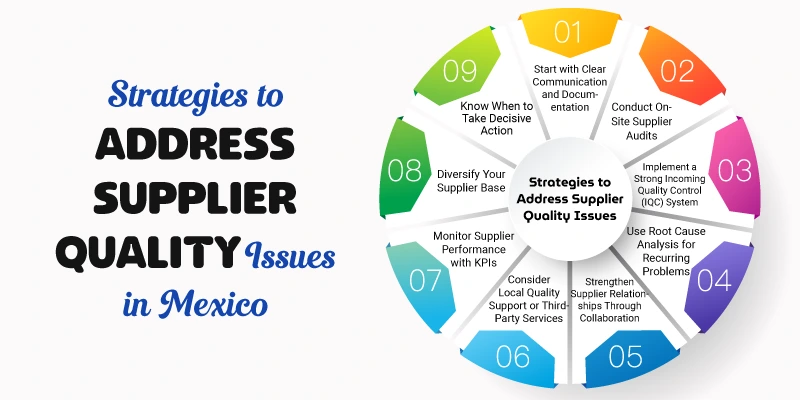How to Solve Supplier Quality Issues in Mexico
Mexico is a critical manufacturing partner for companies looking to optimize cost, lead times, and logistics, especially for North American markets. But even with its strategic advantages, supplier quality issues can quickly erode those benefits. Whether it's inconsistent product specs, late deliveries, or high defect rates, quality problems can disrupt your supply chain, damage customer relationships, and inflate costs.

The good news? These challenges are solvable. With a proactive approach and the right local strategy, you can get supplier performance back on track and prevent issues before they escalate. Here's how.
Common Supplier Quality Issues in Mexico
Supplier quality issues in Mexico can impact manufacturing efficiency and product consistency. Below are some of the key challenges businesses may face when working with suppliers in the region:
- Inconsistent Product Quality
- Limited Quality Control Systems
- Workforce Turnover and Skill Gaps
- Inadequate Root Cause Analysis
- Communication Barriers
- Supply Chain Disruptions
- Failure to Meet Regulatory Standards
- Limited Technological Capabilities
- Lack of Effective Change Management
- Inconsistent Lead Times and Delivery Delays
Strategies to Address Supplier Quality Issues in Mexico
To effectively manage and resolve supplier quality issues in Mexico, businesses can implement a combination of proactive strategies aimed at improving communication, enhancing quality control, and strengthening supplier relationships. Here are key approaches to consider:

1. Start with Clear Communication and Documentation
Many quality problems begin with a lack of clarity. Misunderstandings around product specs, tolerances, materials, and packaging can lead to costly mistakes.
What to do:
- Provide detailed technical drawings and specifications.
- Clarify standards using both English and Spanish documentation where necessary.
- Define acceptance criteria, testing methods, and inspection points upfront.
- Use a quality agreement to formalize expectations on both sides.
Clear documentation sets the foundation for accountability and consistency.
2. Conduct On-Site Supplier Audits
An on-site audit is one of the most effective ways to understand a supplier’s true capabilities and identify gaps in their quality system.
Focus on:
- Production processes and quality control procedures.
- Training and skill levels of employees.
- Equipment maintenance and calibration.
- Incoming material inspection and traceability.
Audits should not only assess compliance but also help identify areas for improvement.
3. Implement a Strong Incoming Quality Control (IQC) System
If you’re relying solely on your supplier’s internal inspections, you’re taking a risk. Implement your own incoming inspection process to catch defects before they reach production or customers.
Key steps:
- Inspect critical components upon arrival.
- Set up sampling plans based on defect history and supplier performance.
- Track defects by type and frequency to identify trends.
This helps contain quality issues early and reduces downstream impact.
4. Use Root Cause Analysis for Recurring Problems
When defects repeat, you need more than quick fixes; you need to get to the root of the issue. Otherwise, the same problems will keep resurfacing.
Effective tools include:
- The 5 Whys method.
- Fishbone (Ishikawa) diagrams.
- Failure Mode and Effects Analysis (FMEA).
Once the cause is found, work with the supplier to implement corrective and preventive actions (CAPA), and verify their effectiveness over time.
5. Strengthen Supplier Relationships Through Collaboration
Quality problems aren’t always a sign of bad intent. In many cases, suppliers lack resources, training, or feedback. Rather than cutting ties immediately, try developing the supplier.
You can:
- Share quality metrics regularly.
- Offer technical support or joint improvement projects.
- Provide training on lean manufacturing or process control.
- Set achievable improvement goals with regular reviews.
Building trust and communication often leads to better performance over time.
6. Consider Local Quality Support or Third-Party Services
Distance and language barriers can slow down issue resolution. Having a local presence or working with a local quality partner in Mexico can help bridge the gap.
Benefits include:
- Real-time quality inspections and reports.
- Faster response to problems on the shop floor.
- Independent verification of supplier claims.
- Smoother implementation of corrective actions.
Local support increases visibility and ensures that issues are handled promptly.
7. Monitor Supplier Performance with KPIs
Tracking supplier performance over time helps you spot problems early and hold partners accountable.
Useful KPIs:
- Parts per million (PPM) defect rate.
- On-time delivery rate.
- Cost of poor quality (COPQ).
- Number of non-conformances per shipment.
Review these metrics regularly with your suppliers to encourage continuous improvement and highlight problem areas. To ensure long-term success with your vendors, it’s essential to understand the full scope of Supplier Performance Management .
8. Diversify Your Supplier Base
Overreliance on a single supplier can leave your business vulnerable to disruptions. If one supplier faces quality issues or delays, it can impact your entire production schedule. To mitigate this risk:
- Diversify suppliers: Work with multiple suppliers for critical materials or components to ensure a steady flow of high-quality products.
- Consider dual sourcing: For essential parts, consider dual sourcing to ensure you have an alternative supplier in case of problems.
For a deeper dive into optimizing your supplier quality management, check out our full guide on Supplier Quality Management (SQM).
9. Know When to Take Decisive Action
Not every supplier relationship can or should be saved. If problems persist despite multiple interventions, it may be time to take stronger measures.
Options include:
- Reducing order volumes to mitigate risk.
- Putting the supplier on probation with clear targets and timelines.
- Qualifying backup or alternative suppliers as a contingency.
- Transitioning to a new supplier if the risks outweigh the benefits.
The key is to make decisions based on data.
Real Case Study: Supplier Quality Issues in Mexico's Automotive Industry
Background:
A global automotive manufacturer with a production facility in the United States sourced critical parts from a Tier 2 supplier based in Mexico. The supplier was responsible for providing aluminum die-cast components for the assembly of engine parts. These components were essential for the timely production of engines, which had strict quality and delivery requirements. However, the automotive manufacturer began experiencing increasing defects in the supplied components. The defects included surface imperfections, incorrect dimensions, and faulty castings, leading to delays on the assembly line and substantial rework costs.
Problem Identification:
The supplier's parts failed to meet the company’s quality standards, causing delays in the production process. The main issues identified were:
- Surface Defects: Some components had visible surface imperfections that affected the performance and aesthetics of the final product.
- Dimensional Inaccuracies: Key parts failed to meet specified tolerances, preventing them from fitting correctly in the assembly process.
- Non-compliance with Standards: The supplier had failed to maintain necessary documentation, such as traceability of materials and records of inspections, which raised concerns about their overall quality management systems.
- Lack of Skilled Labor: The workforce at the supplier’s facility had high turnover rates, leading to inconsistent manufacturing practices. Many new employees had not received sufficient training on the specific quality standards required for the automotive parts.
Resolution Process:
1. Supplier Audit and Root Cause Analysis
The automotive manufacturer immediately initiated a supplier audit to understand the underlying causes of the quality issues. A team of quality experts visited the supplier’s facility in Mexico to evaluate their production processes, quality control systems, and employee training programs. During the audit, several key issues were identified:
- Inadequate Quality Control Systems: The supplier lacked proper inspection stations and automated systems to detect defects early in the production process.
- Machine Calibration Issues: Some of the die-casting machines were not properly calibrated, leading to dimensional inaccuracies in the final products.
- Employee Training Deficiencies: A significant gap in training for new employees was discovered, which led to inconsistent production practices.
2. Collaborative Problem-Solving
After identifying the root causes, the automotive manufacturer worked closely with the supplier to implement corrective actions. These included:
- Improvement of Quality Control Processes: The supplier introduced more stringent quality checks throughout the production process, including additional inspection stations at critical points in the production line. They also invested in automated inspection systems to detect surface defects and dimensional inaccuracies.
- Employee Training Program: The automotive manufacturer provided training and certification programs for the supplier’s workforce. This included detailed training on industry-specific quality standards and best practices for die-casting and dimensional accuracy.
- Machine Calibration and Upgrades: The supplier invested in machine calibration and maintenance to ensure that all equipment was operating at the required standards. This step helped reduce the likelihood of defects caused by faulty machinery.
3. Ongoing Monitoring and Support
The automotive manufacturer did not stop after implementing the corrective measures. They established a continuous monitoring system to track supplier performance over time. This included:
- Regular Quality Audits: The manufacturer set up quarterly audits to ensure that the supplier adhered to the new quality standards and maintained proper documentation.
- Frequent Communication: To avoid language and cultural barriers, the manufacturer established a bilingual quality control team that worked closely with the supplier to address any potential issues in real time.
- Supplier Development Program: The automotive manufacturer began to treat the supplier as a strategic partner, investing in their long-term development through shared knowledge and resources.
Outcome:
By implementing these corrective actions and collaborating closely with the supplier, the automotive manufacturer was able to resolve the quality issues. The results included:
- Reduction in Defect Rates: The supplier’s defect rate dropped by 45% within the first six months of the corrective actions being implemented.
- Improved On-Time Delivery: With fewer defects and smoother production processes, the supplier was able to meet delivery deadlines, reducing delays in the automotive manufacturer’s assembly lines.
- Stronger Partnership: The collaborative approach helped build a stronger relationship with the supplier, leading to more open communication and a better understanding of quality expectations.
- Cost Savings: The reduction in defects and rework resulted in cost savings, as the automotive manufacturer no longer had to deal with costly returns or additional labor to fix faulty parts.
By identifying the root causes of the issues and working together on corrective actions, both the supplier and the manufacturer benefited from improved quality, efficiency, and cost savings.
Turn Supplier Quality Challenges into Strategic Advantages with AMREP
At AMREP Mexico, we know that supplier quality issues can have a significant impact on your business operations, but with the right approach, these challenges can be transformed into opportunities for growth and improvement. By addressing the root causes of quality problems, fostering clear communication, and investing in supplier development, businesses can strengthen their supply chain and build long-term, reliable partnerships.
The insights highlight the importance of collaboration and continuous improvement, both of which are core principles at AMREP Mexico. We are here to support you in overcoming supplier quality challenges, ensuring your products meet the highest standards, and helping your business stay competitive in a rapidly evolving global market. With AMREP by your side, you can turn supplier quality issues into a strategic advantage.
For tailored support and solutions, explore our Supplier Quality Services to Manage Mexican Manufacturers.


